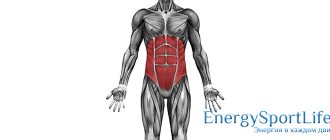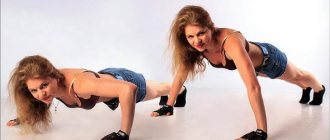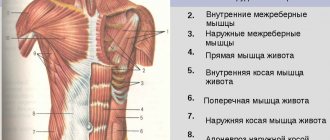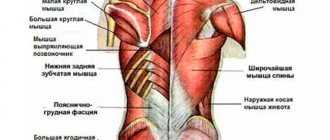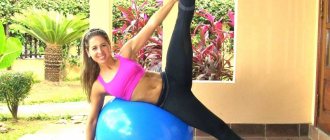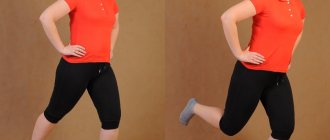Despite the fact that in sports the transverse abdominal muscle is almost never singled out as an object for pumping, it has an incredible impact not only on physical fitness, but also on human health. The stabilization of the spine and the correct location and functioning of the internal organs depend on it. Moreover, exercises for the transverse abdominal muscle are not always present in the training program, which leads to insufficient load and weakening. Understanding the anatomical features, structure and exercises necessary for pumping will strengthen the tone, as well as eliminate many problems and health risks.
Anatomy and function of the transverse abdominis muscle
Anatomically, the transverse abdominal muscle belongs to the deep muscles (3rd layer). Located directly under the inner braid (2nd layer). Presented in the form of a thin plate with transversely directed beams.
The transverse abdominal muscles are covered with their own fascia. They originate from:
- The inner surface of the 7-12 ribs (due to the introduction of teeth into the muscular part of the diaphragm).
- Inner lip of the iliac crest.
- Inguinal ligament (lateral third).
- Lumbothoracic fascia.
Attached to the linea alba.
The main function of the transverse abdominis muscle is to pull the ribs towards the midline, thereby maintaining the natural position of the internal organs.
Swing with bent leg
During this exercise, the main load is directed to the oblique abdominal muscles, but the rectus abdominis, quadriceps and tensor fasciae lata (hip muscles) are also worked.
Performance. Lie on the floor, put your hands behind your head, bend your knees. The feet should rest on the floor. Perform a crunch in which the right elbow reaches behind the left knee toward the middle of the thigh and the knee moves toward the elbow. While performing the exercise, try to raise your upper body so that your shoulder blades come off the floor. The lower back should be pressed to the floor. Do not press your chin to your neck or pull yourself up with your arms. When twisting, exhale; in the starting position, inhale.
The closer the feet are to the pelvis, the greater the load.
A simpler option for performing this exercise is to stretch the non-working arm to the side (forming a straight line with the shoulder girdle) and press it to the floor. This will give you extra support while twisting.
Perform 30 repetitions on each leg.
Why train the transverse abdominis muscle?
From a health perspective, not a sporting one, it is one of the most important structural elements of the abdominal muscles. However, everyone needs to train the transverse abdominal muscle, regardless of their occupation. In addition to holding the organs, the ability to maintain a straight body position directly depends on its tone. Also, training the transverse abdominal muscle is one of the best types of hernia prevention, especially for people who lead a sedentary lifestyle or have a sedentary job.
If we highlight the main reasons for which we should pump up the transverse abdominal muscle, we should note:
- Visual reduction of the abdomen and improvement of tone.
- Prevention of hernias.
- Maintaining organs in their natural position.
- Improving abdominal function.
- The ability to maintain a straight body position for a long time without fatigue and “bending” forward.
For women, exercises for the transverse abdominal muscle are one of the fastest and most effective ways to make your waist thinner.
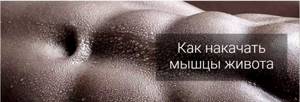
However, not everyone knows that the much-desired sculpted and flat stomach shape depends not so much on the abdominal muscles, but on the transverse abdominal muscle. We'll look at the most effective methods for training this underappreciated muscle group. It is the transverse abdominal muscles, these modest hard workers that cannot be trained to relief due to their “deep” location (unlike the abdominal muscles), that are primarily responsible for the tone of our bellies. Unfortunately, the vast majority of people are unaware of the important role of the transverse muscles in the formation of a flat stomach.
and those who purposefully train this muscle group are quite rare.
Meanwhile, training the surrounding muscles is not a difficult and painstaking task and in terms of energy consumption it is much easier to train the abdominal muscles. You don't even need to go to the gym or find time in your daily routine to do this. Everything is much simpler.
In this article, we will not go into detail about the structure and physiology of the transverse abdominal muscles. The schematic representation of the torso muscles presented below will make it possible to understand what exactly we are going to train.

The most curious can get the information they need about the transverse abdominal muscles from the profile article on Wikipedia. We only note that the main function of this muscle is to reduce the volume of the abdominal cavity
and maintenance of internal organs. Accordingly, if the muscle is weakened, due to a sedentary lifestyle or lack of exercise, the volume of the abdominal cavity grows, and the stomach grows along with it...
So, how to effectively and easily “pump up” the transverse abdominal muscles? After reading the article to the end, you will be convinced that everything is ridiculously simple - exercises for training the main abdominal muscles can be done almost at any time, whether you are sitting at your desk or preparing dinner at home, or even walking down the street. The main thing is desire and perseverance. I don’t want to say platitudes, but the golden rule is appropriate here too - only regular training can give good results.
Exercises for the transverse abdominal muscles while standing
It is most convenient to perform this exercise while lying on your back, but it is quite acceptable to do it standing or sitting, or even while walking.

- Starting position for the exercise.
- Inhale as deeply as possible and push your stomach forward a little.

- Forcefully exhale all the air from your lungs and pull your stomach in as much as possible, as if you want to touch your spine with it.
- Stay in this state for a few seconds. Next, inhale and relax your muscles, trying to push your stomach out as much as possible.
Repeat the entire cycle 8-10 times, take a break and do a few more sets of 8-10 times each. Over time, increase the duration and number of repetitions.
If you cannot pull in your stomach much, it means that the transverse muscles are already quite weakened . Don't try too hard - the results will definitely improve over time. You can also help your muscles a little by lightly pressing your stomach with your hand while doing the exercise.
Training the transverse abdominal muscles while lying down
In a horizontal position, it is significantly easier to train the transverse muscles. True, the effectiveness of the training is slightly lower. Lie down on a moderately hard surface, relax and perform all the steps described for the previous exercise.

- Starting position - breathe calmly, then take a fairly deep breath.

- As you exhale, pull in your stomach and try to hold this position for as long as possible without stopping breathing. Relax and repeat.
- Over time, try to increase the duration of each repetition within comfortable limits.
Useful tips
It is advisable to do exercises for the transverse abdominal muscles no earlier than a couple of hours after eating to avoid abdominal pain. In addition to performing the exercise, it is also recommended to always try to keep the transverse abdominal muscles in tension, drawing in and straining it for as long as possible, especially when you can easily control yourself without being distracted by other things. Over time, this will also become a good habit, and will quietly cease to require any effort on your part. The stomach will become flatter and more beautiful.
Now the most important thing is not to expect quick and impressive results. Otherwise, disappointment is inevitable. The first results from training the transverse abdominal muscles are not a flatter stomach at all, but for now only a deeper retraction when performing the exercise and a noticeable feeling of “tension.” They will become noticeable no earlier than two to three weeks after the start of daily training. Ideally, such exercises should become a good habit for life. It is very useful to simultaneously strengthen the abdominal muscles using standard exercises and crunches.
By the way, these simple exercises will not only strengthen the abdominal muscles and make the abs flatter and more prominent, but also create a light massage of the internal abdominal organs, which additionally benefits the body.
Workout Features
The main problem is that standard abdominal exercises that are popular in fitness do not engage the transverse muscle. This is precisely the reason that even with trained external muscles, the overall aesthetics of the torso is far from ideal (the stomach protrudes, the waist visually becomes larger).
The second problem is the correct preparation of the training program. There are two main ways to work out the target zone:
- After basic abdominal exercises.
- On a separate day.
It is much more effective to allocate a separate day for pumping. This will ensure that it is loaded so that the external parts of the press do not take on most of the load. If you have no time at all, you can train it after the main abdominal block. In this case, the outer muscles will already be tired, which will provide the necessary tension for the inner layer.
To work effectively, it is enough to allocate no more than 2 short sessions per week, but only between meals (so that the stomach is empty).
Exercises for the rectus abdominis muscle
Exercises for the abdominal muscles can be done in any conditions. To properly work out your abdominal muscles, you don’t need new-fangled exercise machines. But we will also look at various movements in the gym.
Exercises for home
Most home exercises are variations of abdominal crunches. In general, the torso is pulled towards the knees. During the reverse movement, the knees move towards the body.
Straight crunches on the floor
The simplest option that is suitable for both beginners and experienced athletes. To perform the exercise you only need the floor.
Technique:
- Starting position (IP) – lying on the floor, legs bent at the knees, hands located near the chest. To increase the load, you can cross your arms behind your head and put your legs on a chair.
- Slowly raise your shoulders and upper body. The amplitude is small and is designed for a powerful contraction of the upper abdominal muscles. The lower back should not come off.
- Pause for a second at the peak point, tense your abdominal muscles as much as possible, and then return to the IP under control.
For more experienced athletes, a good option is to use additional weights that can be held at chest level or at arm's length.
© fizkes — stock.adobe.com
Reverse crunches
There are several variations of this exercise. All of them are aimed primarily at the lower abs. The simplest execution is on the floor.
Technique:
- IP - lying on the floor, legs half-bent and slightly torn off the floor.
- Maintaining the position of your legs, bring your knees towards your chest.
- After holding for a second or two, return your legs to the IP position.
Throughout the entire exercise, the legs do not touch the floor; tension should be maintained in the abdominal muscles.
© artinspiring — stock.adobe.com
A more advanced variation is performed on a bench. If you don’t have a bench at home, stools or a sofa will do.
Technique:
- IP - lying on a bench, half-bent legs hanging from the bench, hands providing support.
- Bring your knees towards your chest.
- Return your legs to IP.
Due to the unstable position of the pelvis and increased amplitude, this exercise is more effective. It is important to work with the press. A common mistake is to over-connect the hips. In the absence of control of the abdominal muscles, the hips are involved almost automatically. Therefore, there is no point in performing a more complex version if the athlete’s training allows only a simple movement to be performed correctly.
An even more advanced option is reverse crunches on an incline bench. The execution scheme is similar.
© Makatserchyk — stock.adobe.com
Plank
Nowadays, the plank is one of the most popular abdominal exercises. The buttocks, back and arms work together with the abdominal muscles. By doing a plank along with crunches, you will quickly achieve noticeable results.
There are several types of planks:
- on straight arms;
- on the elbows;
- with an outstretched arm and/or leg;
- lateral.
All of these variations are suitable for training the rectus muscle, with the exception of the last one.
Scheme for performing a full plank on straight arms:
- Lie face down on the floor.
- Rise up so that you are standing on your palms and toes, with your body straight.
- Keeping your breathing even, stand in this position for as long as possible.
© romanolebedev — stock.adobe.com
Legs can be kept together or spread apart. The press should be tense all the time. At a certain stage, the abdominal muscles will turn on powerfully automatically, but at an early stage it is worth controlling the degree of their tension.
Other varieties are performed in a similar way.
© Makatserchyk — stock.adobe.com
Beginners do not need to stand until they pass out. The first step is to prepare the muscles. On the other hand, after mastering the straight arm plank, it is recommended to combine this option with more complex ones.
Experienced athletes can use additional weights.
Hanging Leg Raise
If you have a horizontal bar at home, the training program can and should be supplemented with hanging leg raises. As with other exercises, there is variability here.
Classic technique:
- IP - hanging on the crossbar.
- Pull your knees bent towards your chest.
- After a second pause, slowly return to the IP.
© Jacob Lund — stock.adobe.com
In a more advanced version, the legs are straight. The final position is parallel to the floor.
Having mastered this variation, move on to V-shaped lifts - touching the crossbar with your feet or raising them to an angle of 45 degrees relative to the floor.
© Makatserchyk — stock.adobe.com
"Corner"
Another effective exercise is the corner. Legs hanging on the horizontal bar can not only be raised/lowered, but also kept in a fixed position - parallel to the floor. The preparation indicator is the time during which the athlete can hold in the desired position.
© Vasyl — stock.adobe.com
The exercise is aimed not so much at visual development, but at increasing abdominal strength. This is a great help for improving your performance in other exercises.
Exercises in the gym
Exercise machines allow you to diversify your workouts, but you shouldn’t get too carried away with them. The movements described above are enough for the eyes, but if you get bored, no one will forbid you to turn to modern training machines for help. They are also great for strength work, as you can vary the load.
"Prayer"
For training you will need an overhead pulley or crossover with a rope handle. In essence, these are ordinary twists, strengthened due to increased resistance.
Technique:
- IP - kneeling in front of the block, hands holding the ropes, body tilted forward.
- Using your abs, bend over and twist so that your elbows are close to the floor.
- Return to IP.
The weight should be chosen to minimize the involvement of the back and hips, while still providing sufficient stress on the abdominal muscles.
Crunches in the simulator
If you have a special abdominal machine, you can do crunches in it. The scheme is similar. The difference is that the back is fixed here, and the body is located almost vertically.
The best exercises for the transverse muscle
An important condition for effectively pumping the transverse abdominal muscle is muscle concentration. Without it, even the most effective movements will not bring any benefit, since the load will be taken by the muscles of the outer layer. Therefore, during the period of mastering the technique, it is recommended to simultaneously improve muscle control.
Exercise "Vacuum"
It is generally accepted that a “vacuum” gives “wonderful abs” and it was this that became the key to Arnold Schwarzenegger’s ideal waist. Modern sports research proves that vacuum is almost useless for the outer layer. However, it is best suited for deep abdominal areas. It is considered the most effective exercise for the transverse abdominal muscle for men.
Technique:
- Stand up straight. Hands down, feet shoulder-width apart. The back is straight.
- Take a powerful breath and push your abdominals forward (using your muscles).
- After 1-2 seconds of tension, exhale powerfully, pulling your stomach towards your ribs as much as possible.
- Hold the position for 3-5 seconds, then inhale and repeat the movement.

It is optimal to perform 7-10 breaths per workout. It is not the number of repetitions that is important, but the force of exhalation and the muscle tension that you can hold. It is also strictly not recommended to increase the time you hold your breath. This can have a detrimental effect on blood vessels and even lead to loss of consciousness. The main method of progression is muscle tension and the number of inhalations/exhalations in a series (no more than 15 per workout).
Plank exercise
Despite the fact that the plank is often criticized for its low effectiveness for the abs (oblique and straight), for the inner layers this is one of the most useful exercises.
Technique:
- Take a lying position, as for push-ups. Press your toes and your entire forearm into the floor (located parallel to each other). There is a right angle at the elbow, the body forms a single straight line from the neck to the heels.
- Maintain your current position for as long as possible.

Beginners are advised to hold the position for up to 30-40 seconds. Advanced athletes – from 60 to 90 seconds. A plank for more than one and a half minutes is considered ineffective, since in order to stabilize the position, the load will “go” to other groups.
Pelvic bridge
A great move, but only if done with the right style. The classic power bridge version is not suitable for this task. The movement should be performed without weight, with a delay at the peak point of up to 4-5 seconds.
Technique:
- Lie on the floor, place your arms along your body. Bend your legs at the knees.
- Lift your pelvis off the floor and lift it so that your body forms a straight line from your knees to your shoulders.
- Hold this position for 3-5 seconds, while concentrating tension (while exhaling).
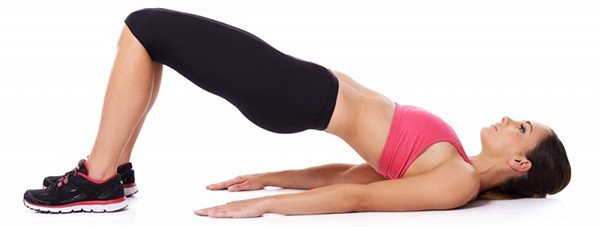
It is important to make the bridge so that the shoulder blades lie on the floor. The option of resting on a bench is not suitable in this case.
Training and set of exercises
The most effective workouts are those that have a direct effect on the transverse muscle. However, it is necessary to perform them regularly. A special complex is provided.
Vacuumization

Abdominal vacuum
Creating a vacuum in the abdomen is considered one of the simplest exercises. Its implementation gives the effect not only of the oblique lateral muscle tissue, but also of the abs. This workout needs to be done several times a day. It is not necessary to adhere to a special environment, since you can practice in public places, at work, while walking with your child, without attracting attention.
- We stand shoulder-width apart, inhale deeply, tensing our stomach.
- We gradually release it from the lungs, while simultaneously drawing in the longitudinal abdominal muscles.
- Hold your breath for 3 seconds.
- We repeat exercises for the transverse abdominal muscle for women 8-10 times.
In this way, all the important tissues of the abdomen are pumped, it becomes flat and neat. The same training is recommended for girls and young mothers to perform the same workout using dumbbells when predicting the appearance of a hernial protrusion.
After the first lesson, pain in the muscles may occur, however, there is no need to stop doing the exercises.
Exercise "Anti-vacuum"
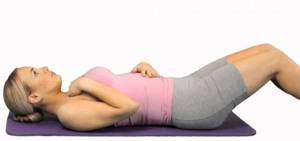
Anti-vacuum
The complex is performed in a lying or standing position. It is important that there is a flat surface behind your back on which you can lean. We do it according to the algorithm.
- We take a deep, slow breath.
- We stretch out the stomach, while simultaneously stretching the release of air from the lungs for 10-15 seconds.
- Inhale again and protrude the abdomen to the maximum.
- This kind of gymnastics should be done daily 10-15 times in two approaches with a break of 30 seconds.
It is advisable to use the same time to strengthen the abdomen so that the muscles are prepared and the body can form a healthy habit.
It is important to learn how to work the abdominal muscles correctly, to feel their tension and work.
Raising the body to the feet
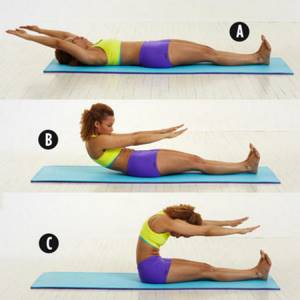
Raising the body to the feet
The following type of exercise for the transverse abdominal muscle is equally suitable for men and women. The degree of pumping may differ only from body weight and the volume of fat deposits in the abdominal area. Rules of implementation that contribute to the appearance of a chic belly:
- We lie down on the floor and straighten our arms and legs.
- Keep your arms straight in front of you.
- Raise your body until your fingers are level with your toes.
- Slowly lower your body.
- We perform 10-12 repetitions without breaks.
The next approach to the complex can be completed after a 2-3 minute break.
Complex "Vint"
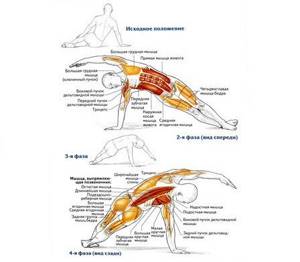
Complex Vint
An unusual and very effective twist that must be performed while lying on your back.
- We pull our legs, bent at the knees, towards the buttocks, and place our arms along the body at the seams.
- We lift the body while simultaneously turning the torso to the left and then to the right.
- We try to close our hands in front of us, making a circle.
- The legs should turn in the opposite direction: first to the right and then to the left.
- Return to the starting position without your head touching the floor.
It is necessary to perform 10-15 repetitions, depending on the load on the muscle mass, you need to feel its contraction.
Exercise "Birch"

Technique for performing the Birch exercise
This workout allows you to pump up the deep abdominal muscles, while at the same time improving your balance and eliminating the effects of diastasis and hemorrhoids.
- We get up to the starting position: we lie on the floor with our backs, hold our straight legs vertically in front of us.
- We stretch our toes upward, helping ourselves with our palms, holding our lower back.
- Slowly lower our legs. The exercise should be performed for 7-10 repetitions, making two approaches with a slight interval for rest.
Only constant practice can produce results. All exercises must be performed at least 4 times a week. Be sure to take rest between daily workouts.
Exercise "Board" or "Plank"

Planck exercise
Designed to work the transverse muscle. It is better to perform it before finishing gymnastics for weight loss. We rest our elbows on the floor, straighten our legs and stand on our toes. The face is lowered, the head is at shoulder level. You must hold this position for 20 seconds. Each time the duration of the exercise must be increased.
In combination, you can use standard exercises to not only pump up a woman’s transverse abdominal muscle, but also to relax her after exercise: leg raises, simple twisting, leg raises on the horizontal bar.
